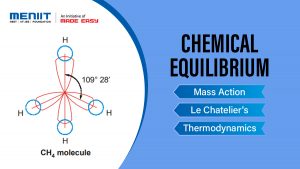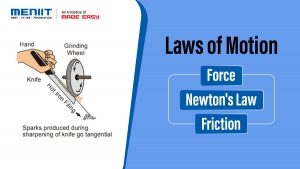Work, Energy and Power
Work Done By A Constant Force
Consider an object undergoes a displacement S along a straight line while acted on a force F that makes an angle θ with S as shown.
The work done W by the agent is the product of the component of force in the direction of displacement and the magnitude of displacement.
i.e., W = FS cos θ Work done is a scalar quantity and its S.I. unit is N-m or joule (J). We can also write work done as a scalar product of force and displacement.
W = F→. S→.
Unit:
- Joule [S.I.] : Work done is said to be one Joule, when 1 Newton force displaces the body through 1 meter in its own direction.
From W = F.S
1 Joule = 1 Newton × 1 metre
- Erg [C.G.S.] : Work done is said to be one erg when 1 dyne force displaces the body through 1 cm in its own direction. From W = F S 1 Erg = 1 Dyne × 1 cm Relation between Joule and erg 1 Joule = 1 N × 1 m = 105 dyne × 102 cm = 107 dyne × cm = 107 Erg
Nature of Work Done
Positive work
Positive work means that force (or its component) is parallel to displacement

The positive work signifies that the external force favours the motion of the body.
Examples:
- When a person lifts a body from the ground, the work done by the (upward) lifting force is positive.

- When a lawn roller is pulled by applying a force along the handle at an acute angle, work done by the applied force is positive.

- When a spring is stretched, work done by the external (stretching) force is positive.

Maximum work : Wmax = FS
When cos = maximum = 1 i.e. θ = 0°
It means force does maximum work when angle between force and displacement is zero.
Negative work
Negative work means that force (or its component) is opposite to displacement i.e.

The negative work signifies that the external force opposes the motion of the body.
Examples:
- When a person lifts a body from the ground, the work done by the (downward) force of gravity is negative.

- When a body is made to slide over a rough surface, the work done by the frictional force is negative.

- When a positive charge is moved towards another positive charge. The work done by electrostatic force between them is negative.

Minimum work : Mmax = -FS
When cos = minimum = -1 i.e. θ = 180°
It means force does minimum [maximum negative] work when angle between force and displacement is 180°.
Zero work : Under three condition, work done becomes zero W = FScosθ = 0
- If the force is perpendicular to the displacement [F→⊥ S→]
Example:
- When a coolie travels on a horizontal platform with a load on his head, work done against gravity by the coolie is zero.
- When a body moves in a circle the work done by the centripetal force is always zero.

- If there is no displacement [S = 0]
Example:
- When a person tries to displace a wall or heavy stone by applying a force then it does not move, the work done is zero.
- A weight lifter does work in lifting the weight off the ground but does not work in holding it up.

- If there is no force acting on the body [F = 0]
Example: Motion of an isolated body in free space.
Work Done By A Variable Force
When the magnitude and direction of a force varies with position, the work done by such a force for an infinitesimal displacement is given by dW = F→.ds→.
The total work done in going from A to B as shown in the figure is

Graphical Approach
Let a body, whose initial position is xi, is acted upon by a variable force (whose magnitude is changing continuously) and consequently the body acquires its final position xf.
Let F→ be the average value of variable force within the interval dx from position x to (x + dx) i.e. for small displacement dx. The work done will be the area of the shaded strip of width dx. The work done on the body in displacing it from position xi to xf will be equal to the sum of areas of all the such strips.
dW = F→dx

i.e. Area under force displacement curve will give work done by the force.
Work Done in Conservative and Non-Conservative Field
Conservative forces: In conservative field work done by the force is independent of the path followed between any two points. Potential energy is defined for conservative forces.
Example: Gravitational force, electrostatic force.
Non-Conservative forces: A force is said to be non-conservative if work done by or against the force in moving a body from one position to another, depends on the path followed between these two positions and for complete cycle this work done can never be zero.
Kinetic Energy
The energy possessed by a body by virtue of its motion is called kinetic energy.

Potential Energy
Gravitational Potential Energy: It is possessed by virtue of height.

Elastic Potential Energy: When a spring is stretched or compressed from its normal position (x = 0)

Types of equilibrium: If net force acting on a particle is zero, it is said to be in equilibrium.

| Stable | Unstable | Neutral |
|---|---|---|
| When a particle is displaced slightly from a position, then a force acting on it brings it back to the initial position, it is said to be in stable equilibrium position. | When a particle is displaced slightly from a position, then a force acting on it tries to displace the particle further away from the equilibrium position, it is said to be in unstable equilibrium. | When a particle is slightly displaced from a position then it does not experience any force acting on it and continues to be in equilibrium in the displaced position, it is said to be in neutral equilibrium. |
| Potential energy is minimum. | Potential energy is maximum. | Potential energy is constant. |
 |
 |
 |
 |
 |
 |
 |
 |
 |
Law Of Conservation Of Energy
Law Of Conservation Of Energy: For a body or an isolated system by work-energy theorem we have

For an isolated system or body in presence of conservative forces the sum of kinetic and potential energies at any point remains constant throughout the motion. It does not depends upon time. This is known as the law of conservation of mechanical energy.

i.e. if the kinetic energy of the body increases its potential energy will decrease by an equal amount and vice-versa.
Motion in a Vertical Circle
Body Suspended with the Help of a String
Imagine an arrangement like a simple pendulum where a mass m is tied to a string of length r, the other end of the string being attached to a fixed point O.
Let the body initially lie at the equilibrium position A. Let it be given a velocity v1 horizontally. If the velocity is small then the body would make oscillations in the vertical plane like a simple pendulum.

Let us now find the velocity of projection v1 at the lowest point A required to make the body move in a vertical circle.
The following points can be noted while considering the motion:
- The motion along the vertical circle is non-uniform since the velocity of body changes along the curve. Hence the centripetal acceleration V2/r must also change, where v is the instantaneous velocity of the body at any point on the circle.
- The resultant force acting on the body (in the radial direction) provides the necessary centripetal force.
- The velocity decreases as the body moves up from A to B, the topmost point.
When the body is at A, the resultant force acting on it is T1 – mg,
where T1 is the tension in the string.

The tension is always positive (even if v1 is zero). Therefore, the string will be taut when it is at A. The condition for the body to complete the vertical circle is that the string should be taut all the time i.e., the tension is greater than zero.
The region where the string is most likely to become slack is above the horizontal radius OC. Also the tension would become the least when it is at the topmost point B. Let it be T2 at B and the velocity of the body be v2. The resultant force on the body at B is

The particle will describe complete circle if both v2 and T2 do not vanish till the particle reaches the highest point.
Power
Power of a body is defined as the rate at which the body can do the work

Collision
A collision between two bodies which occurs in a very small interval of time and during which the two bodies exert relatively large forces on each other is called impact. The common normal to the surfaces in contact during the impact is called the line of impact.

If the velocities of the two bodies are directed along the line of impact, the impact is said to be a head on collision as shown in figure (i). If either or both bodies move along a line other than the line of impact, the impact is said to be an oblique collision as in figure (ii).
Newton’s Law of Collision
According to Newton’s experimental law of impact, the ratio of relative speed of separation after collision and the relative speed of approach before collision is a constant. This constant is called coefficient of restitution or coefficient of resilience. For a given pair of materials. It is denoted by e.
Relative velocity of separation after collision ∝ relative velocity of approach before collision

Newton distinguished these three classes of collisions in terms of coefficient of restitution.
- e = 1, the collision is perfectly elastic
- e = 0, the collisions is perfectly inelastic.
- 0 < e < 1, the collisions is inelastic.
| Perfectly elastic collision | Inelastic collision | Perfectly inelastic collision |
|---|---|---|
| If in a collision, kinetic energy after collision is equal to kinetic energy before collision, the collision is said to be perfectly elastic. | If in a collision kinetic energy after collision is not equal to kinetic energy before collision, the collision is said to inelastic. | If in a collision two bodies stick together or move with same velocity after the collision, the collision is said to be perfectly inelastic. |
| Coefficient of restitution e = 1 | Coefficient of restitution 0 < e < 1 | Coefficient of restitution e = 0 |
| (KE)final = (KE)initial | Here kinetic energy appears in other forms. In some cases (KE)final < (KE)initial such as when initial KE is converted into internal energy of the product (as heat, elastic or excitation) while in other cases (KE)final > (KE)initial such as when internal energy stored in the colliding particles is released | The term ‘perfectly inelastic’ does not necessarily mean that all the initial kinetic energy is lost, it implies that the loss in kinetic energy is as large as it can be. (Consistent with momentum conservation). |
Examples:
|
Examples:
|
Example: Collision between a bullet and a block of wood into which it is fired. When the bullet remains embeded in the block. |
Perfectly Elastic Oblique Collision

After perfectly elastic oblique collision of two bodies of equal masses (if the second body is at rest), the scattering angle θ + φ would be 90°.

















